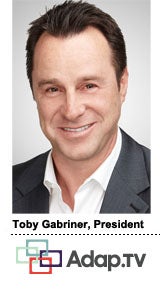 Video ad players like Tremor, YuMe, BrightRoll and Videology are quickly evolving from their ad network beginnings to serve both buyers and sellers in a unified programmatic marketplace.
Video ad players like Tremor, YuMe, BrightRoll and Videology are quickly evolving from their ad network beginnings to serve both buyers and sellers in a unified programmatic marketplace.
Adap.tv is one of those working to create a video ad marketplace with an end-to-end tech stack. The premise is to serve the demand side and the supply side equally. But the term “programmatic” still causes some publishers to blanch and so Toby Gabriner, Adap.tv’s president, would prefer to avoid the word.
“There’s a certain view of programmatic that instantly suggests remnant and cherry-picking audiences,” Gabriner told AdExchanger. “I’ve had some nervousness about Adap.tv being pigeonholed around the idea that we’re completely built around that idea of programmatic. The way we describe it, programmatic is just a subset of the technology tools that we offer.”
Adap.tv is often mentioned in the same breath as Tremor, which has filed its S-1 in preparation for a public offering (And now, it’s public.), and YuMe as a likely candidate to IPO. Like its rivals, the company is betting that some of the roughly $75 billion spent annually on TV ads will make its way online. The strategy involves winning the confidence of advertisers as well as publishers, particularly since Adap.tv says it only focuses on mid- to upper-funnel ad spending.
Adap.tv’s buyers can use its dashboard tools to examine available inventory and make a purchase. Adap.tv’s revenue comes from clients – both buyers and sellers [ 1] — who are charged based on a percentage of the transactions that run through its main platform and the Adap.tv marketplace.
“Adap.tv offers the sell side a tech stack the lets them manage everything from video yield management to the development of private marketplaces,” Gabriner said.
And Adap.tv promises sellers that it can help them better understand their audiences with a range of analytics tools. It then connects to agency trading desks.
“We’re similar to Google’s stack, where they have AdMeld and DoubleClick for Publishers on the sell-side, the AdX in the middle, and then Invite Media [now called “DoubleClick Bid Manager”] and DoubleClick for Advertisers on the buy side. The only difference with us is that it’s all one technology. We didn’t buy a bunch of companies and string them together.”
Many major publishers still regard that “Google marketplace model” with a degree of suspicion, wondering whether a single company can truly serve both sides equally.
For publishers, the issue boils down to what marketplace can deliver higher effective CPMs. Companies with more attentive client service teams can also help ease any lingering anxiety over programmatic ad sales.
To that end Adap.tv has been staffing up aggressively in the past year, having doubled headcount from 100 employees in April 2012 to 200 as of this month. The San Mateo, CA.-based company intends to hire 100 more people over the next few months.
Everyone in the video space has a plan to unlock TV ad dollars. But hurdles persist. In addition to broadcasters’ view that online video is a mere complement to the 30-second spot, there’s also the problem of audience measurement. For TV, Nielsen’s ratings are the standard. Almost everyone in the industry would argue that those ratings numbers are imperfect, but they represent a common currency that buyers and sellers can agree on.
Like the rest of the online universe, there are competing systems – including Nielsen’s Online Campaign Ratings and comScore’s validated Campaign Essentials, both of which Adap.tv uses.
“The holy grail is being able to do reach and frequency across all devices,” Gabriner said. “Without a common currency, it would be like walking down a street and having to use a special currency for every shop you walk into. And with display sales, that’s how it’s been. Everybody makes up their own metric. The great thing about TV is that billions of dollars are traded using that single Nielsen common currency. Our view is that we need a common currency, but we don’t have to stop there.”
Linear TV buying has become slowly but steadily more data-driven, presenting opportunities for companies like Rentrak and Kantar to disrupt the easy methodologies of Nielsen TV ratings for broadcasters and agencies. As that trend continues, the Adap.tv’s of the world hope to capitalize.
Roni Jenkins, VP and Interactive Marketing Director at TargetCast, endorses Adap.tv for reach and transparency.
“They are a large reach video network, often ranking number two in ComScore in terms of monthly unique visitors,” Jenkins said. “Although we often buy them for their large reach, what makes them different from other video networks is their transparency and ability to allow buyers to pick the particular sites they want to run on, essentially naming your own your price across thousands of sites in a video marketplace.”
Ad viewability is another macro trend affecting video players, but Adap.tv has decided not to participate in a video viewability consortium assembled by TubeMogul last month. BrightRoll, Innovid, LiveRail and SpotXchange have all agreed to support OpenVV (or Open VideoView), a viewability solution for in-stream video ads.
“We’re neutral on the viewability consortium, though I do think it’s an important effort” Gabriner said. “Our stance on the issue is that is has to come out of the MRC and IAB. That’s who will set the standard. In the meantime, we have quite a few initiatives and viewability is an important one. It’s a part of our continued efforts to combat ‘bots’ and fraudulent impressions.”
As for acquisitions, Gabriner says Adap.tv is “always opportunistic,” but there are no immediate plans for the company to go shopping, even as it increasingly looks abroad, particularly to Asia and Australia, for future growth.
On the matter of IPOs, he won’t say a word.













